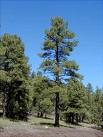Pacific Ponderosa Pine Tree Information
Images of Pacific Ponderosa Pine:






Pacific Ponderosa Pine grows in the following 8 states and provinces:
British Columbia, California, Hawaii, Idaho, Montana, Nevada, Oregon, WashingtonInformation about Pacific Ponderosa Pine:
The Pinus Ponderosa Var. Ponderosa is commonly known as the Bull Pine, Pacific Ponderosa Pine, Ponderosa Pine as well as Western Yellowpine.
The currently accepted scientific name of Pacific ponderosa pine is Pinus ponderosa var. ponderosa Dougl. . Three varieties of ponderosa pine are currently recognized and are distinguished by morphological variations and geographical location : var. arizonica (Engelm.) Shaw - Arizona pine. (classified as a separate species, P. arizonica Engelm.), by some authorities). Occurs in the mountains of extreme southwest New Mexico, southeast Arizona, and northern Mexico. Has shorter cones and narrower cone scale prickles. Usually has five-needle fascicles. var. ponderosa - Pacific ponderosa pine. Extends from the mountains of southern California northward along the Sierra Nevada-Cascade Range to southern British Columbia. Usually has three-needle fascicles. var. scopulorum (Engelm.) - Interior ponderosa pine. Extends from west-central Montana, southward through the mountains, plains, and basins of Colorado, Arizona, and New Mexico. Has a moderate to high proportion of two-needle fascicles.Pacific ponderosa pine ranges from latitude 52 degrees N in the Fraser River Drainage of southern British Columbia south through the mountains of Washington, Oregon, and California to latitude 33 degrees N near San Diego. In the northeastern part of its range it extends east of the Continential Divide to longitude 110 degrees W in Montana and south to the Snake River Plain in Idaho .Pacific ponderosa pine forms climax stands that border grasslands and is also a common seral tree on many other forested sites . Being drought tolerant, it is usually occupies the transition zone between grassland and forest. Climax stands are characteristically warm and dry, and occupy lower elevations throughout their range. Key understory associates in climax stands typically include grasses such as bluebunch wheatgrass (Pseudoroegneria spicata) and Idaho fescue (Festuca idahoensis), and shrubs such as bitterbrush (Purshia tridentata) and common snowberry (Symphoricarpos albus). At higher elevations, Pacific ponderosa pine is seral to trees that are more shade tolerant and moisture demanding. In the Pacific Northwest this generally includes Douglas-fir (Pseudotsuga menziesii), grand fir (Abies grandis), and white fir (A. concolor) . Publications listing Pacific ponderosa pine as an indicator or dominant species in habitat types (hts), community types (cts), and plant associations (pas) are as follows: Area Classification Authority ---- -------------- ------------------------- CA forest (pas) Atzet & Wheeler 1984 CA forest (cts) Erhard 1979 CA forest (hts) Horton 1960 ID forest (pas) Schlatterer 1972 ID forest (cts) Tuhy & Jensen 1982 c ID forest (hts) Steele & others 1981 n ID forest (hts) Cooper & others 1991 MT forest (hts) Pfister & others 1977 OR forest (pas) Kovalchik 1987 OR forest (pas) Hopkins 1979b OR forest (pas) Hopkins & Kovalchik 1983 OR forest (pas) Johnson & Simon 1987 c OR forest (pas) Volland 1985 e OR se WA forest (cts) Hall 1973 WA forest (pas) Williams & Lillybridge 1983 e WA n ID forest (hts) Daubenmire & Daubenmire 1968Some of the information provided here is attributed to:Habeck, R. J. 1992. Pinus ponderosa var. ponderosa. In: Fire Effects Information System, [Online]. U.S. Department of Agriculture, Forest Service, Rocky Mountain Research Station, Fire Sciences Laboratory (Producer). , available at the USDA Fire Effects Information System (FEIS) website